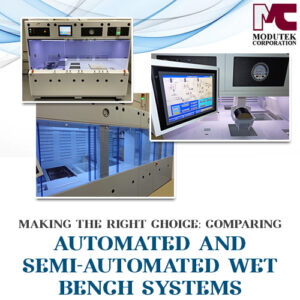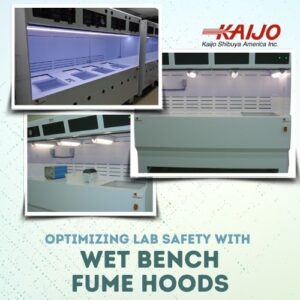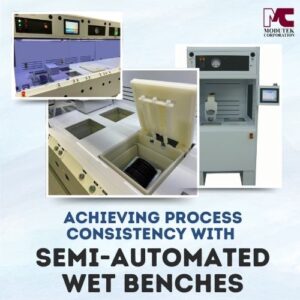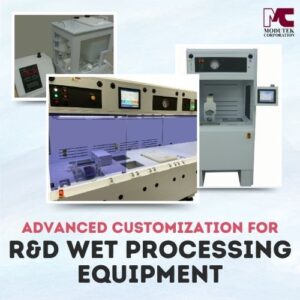
Automated Wet Bench Systems
Automated wet bench systems represent the pinnacle of technological progress for wet process operations. These systems are distinguished by their seamless integration of advanced robotics, precise controls, and sophisticated software. They perform complex wet process steps with unrivaled accuracy and repeatability – with minimal human intervention!
Automated wet bench systems are equipped with cutting-edge robotics that can perform various tasks, including chemical delivery, substrate manipulation, rinsing, and drying. Specialized end effectors, grippers, and robotic arms help these systems deliver their services with high precision and efficiency. This allows the system to run multiple cassettes for sequencing per programmed recipe. These advanced control systems also provide precise handling of process parameters like temperature, flow rates, and timing.
Automation brings numerous benefits to wet process operations, including:
- Enhanced Productivity with optimized throughput
- Improved Accuracy and Consistency
- Reduced Human Error and Safety Risks
- Advanced Process Control
Automated wet bench systems find widespread application in industries requiring high-volume production, stringent quality control measures, and complex process requirements. These industries include:
- Semiconductor Manufacturing
- Microelectronics production
- Photovoltaics
Automated wet bench systems have revolutionized wet process operations, helping industries achieve increased productivity, quality, and efficiency.
Exploring Semi-Automated Wet Bench Systems
Semi-automated wet bench and wet process systems represent an attractive balance between manual and automated processes, offering versatility and customization options. These systems incorporate mechanical components for specific process steps while involving manual operator intervention at other stages. This provides greater control and adaptability so processes can be tailored precisely to specific requirements.
Semi-automated wet bench systems typically use automated chemical delivery systems, robotic substrate handling capabilities, and advanced control interfaces. These components streamline specific aspects of the wet process while allowing operators to handle key steps or manually make necessary adjustments.
Semi-automated wet bench systems offer several advantages, including:
- Flexibility and Customization
- Operator Experience and Intervention
- Cost-Effective Solution
Semi-automated wet bench systems offer value across various industries and applications including:
- Research and Development
- Low Volume or Customized Production
- Specialized Applications
Semi-automated wet bench systems combine manual and automated processes for maximum versatility in some applications, providing adaptable solutions.
Key Considerations in Selecting an Appropriate System
Process Requirements and Complexity
When selecting a wet bench system, it’s essential to consider your operation’s unique process requirements and complexity. Consider the number of process steps involved, the intricacies of chemical reactions, and any particular safety or handling considerations that need to be met. Automated systems excel in such processes, while semi-automated ones offer more customization and adaptability depending on changing requirements.
Throughput and Production Volume
Evaluate your desired throughput and production volume to select an effective system. Automated wet bench systems are tailored toward high-volume production environments where speed and efficiency are essential. In contrast, semi-automated systems allow greater versatility with easier adjustments for lower production volumes or frequently changing processes.
Cleanliness and Precision Needs
Consider the cleanliness standards and precision requirements of your specific application. Automated wet bench systems offer exceptional control of process parameters, minimizing the risk of contamination while assuring high precision and repeatability. If cleanliness and precision are of utmost importance to you, automated systems may be the preferred choice for controlling them effectively.
Cost Considerations and Return on Investment (ROI)
Automated wet bench systems typically have higher upfront costs due to their advanced technology and use of robotics for each process step. They also provide long-term benefits such as increased productivity and reduced labor costs. By contrast, semi-automated solutions may offer more cost-effective solutions, especially for lower production volumes or applications requiring some customization.
Comparison of Automated and Semi-Automated Wet Bench Systems
Performance and Efficiency
Automated Wet Bench Systems:
- Automated systems provide exceptional performance in speed, accuracy, and repeatability.
- Advanced robotics and precise control mechanisms enable rapid processing with minimal cycle times resulting in high throughput levels and reduced cycle times.
- Provides tight process control to minimize variations and deviations, improving yields and product quality and consistent results across runs.
Semi-Automated Wet Bench Systems:
- Offer good performance but slightly lower efficiency compared to fully automated systems in speed and consistency.
- Flexibility and customization options to optimize critical process steps based on real-time observations and knowledge.
Operator Involvement
Automated Wet Bench Systems:
- Require minimal operator involvement as most process steps are handled by robotics and control mechanisms integrated within them.
- Reduced operator involvement allows staff to concentrate on higher-value activities or perform other duties, improving overall operational efficiency and resource allocation.
Semi-Automated Wet Bench Systems:
- Typically involve more manual operator involvement during critical steps or adjustments, with operators actively monitoring and controlling certain aspects of the process to achieve optimal results.
- Operator involvement enhances customization, adaptability, and immediate response to changing process conditions or requirements.
Customization and Scalability
Automated Wet Bench Systems:
- Highly scalable, capable of handling large production volumes, and can easily be integrated into existing production lines.
- Customization options are limited compared to semi-automated systems since automated systems offer standardization and efficiency, making them appropriate for industries with established processes.
Semi-Automated Wet Bench Systems:
- Greater customization options, allowing operators to tailor processes precisely according to individual needs.
- Allow process parameters to be modified with manual intervention capabilities making these systems perfect for applications with varied process needs.
- Are easily scalable to accommodate different production volumes and can be adapted to suit changing process requirements
Cost and Budget Considerations
Automated Wet Bench Systems:
- Typically involve higher upfront costs due to their advanced technologies, robotics, and software integration requirements.
- When considering cost implications, one must assess the potential return on investment (ROI) and overall operational benefits of installing such systems.
Semi-Automated Wet Bench Systems:
- Offer more cost-effective solutions, especially for applications with lower production volumes or customization needs, due to lower upfront costs that make these solutions accessible across a broader spectrum of industries and applications.
- Deliver a lower efficiency level than automated systems, but offer a balanced approach that can meet budgetary constraints of specific operations.
Choosing the Right Wet Bench System for Your Needs
When reviewing wet benches to use for your application, keep the following factors in mind:
Process Requirements: Evaluate the specific process requirements, complexity, and critical steps involved. Determine whether the process requires the precision and consistency of automated systems or the flexibility and customization options.
Throughput and Production Volume: Assess the throughput and production volume needs. Determine if automated wet bench systems are needed for efficiency in a high-volume production environment. For lower-volume production, a semi-automated system may provide the required adaptability.
Cleanliness and Precision: Carefully evaluate the cleanliness and precision requirements for your application. If strict cleanliness standards and precise process control are of utmost importance, automated systems may be an ideal option because they can consistently monitor process parameters.
Cost Considerations: When setting a budget and considering ROI, consider both short- and long-term considerations. Automated systems have higher upfront costs but often result in greater productivity and cost savings over time. Semi-automated systems offer a lower-cost solution and could be suitable for operations with limited capital investment.
Consultations and Assessment of Requirements: Consult with established wet bench system suppliers like Modutek for valuable advice in selecting the appropriate system for your specific needs. Consultation sessions provide an ideal platform to discuss process requirements, operational constraints, customization possibilities, and customization needs before receiving recommendations tailored specifically for your application.
Evaluating of Supplier Expertise: Supplier expertise plays an essential part in successfully implementing your wet bench system. Modutek designs and builds all wet bench systems on-site wet bench systems using in-house experts. With over four decades of industry experience, Modutek offers comprehensive knowledge and expertise in wet bench solutions.
Collaboration With Suppliers for Customized Solutions: Collaborating with suppliers is essential in attaining tailored solutions that precisely match your process requirements. Modutek works directly with customers to collaborate on system design to ensure all specifications are met. By leveraging the expertise of an experienced supplier, you can optimize your wet process operations and achieve the desired results.
The Bottom Line
Selecting the right wet bench system requires careful evaluation of process requirements, throughput, precision needs, and cost considerations. Whether you choose an automated or semi-automated system, Modutek can work with you to design and build a wet bench system that meets all your process requirements. Contact Modutek for a free consultation to discuss your specific process requirements.




